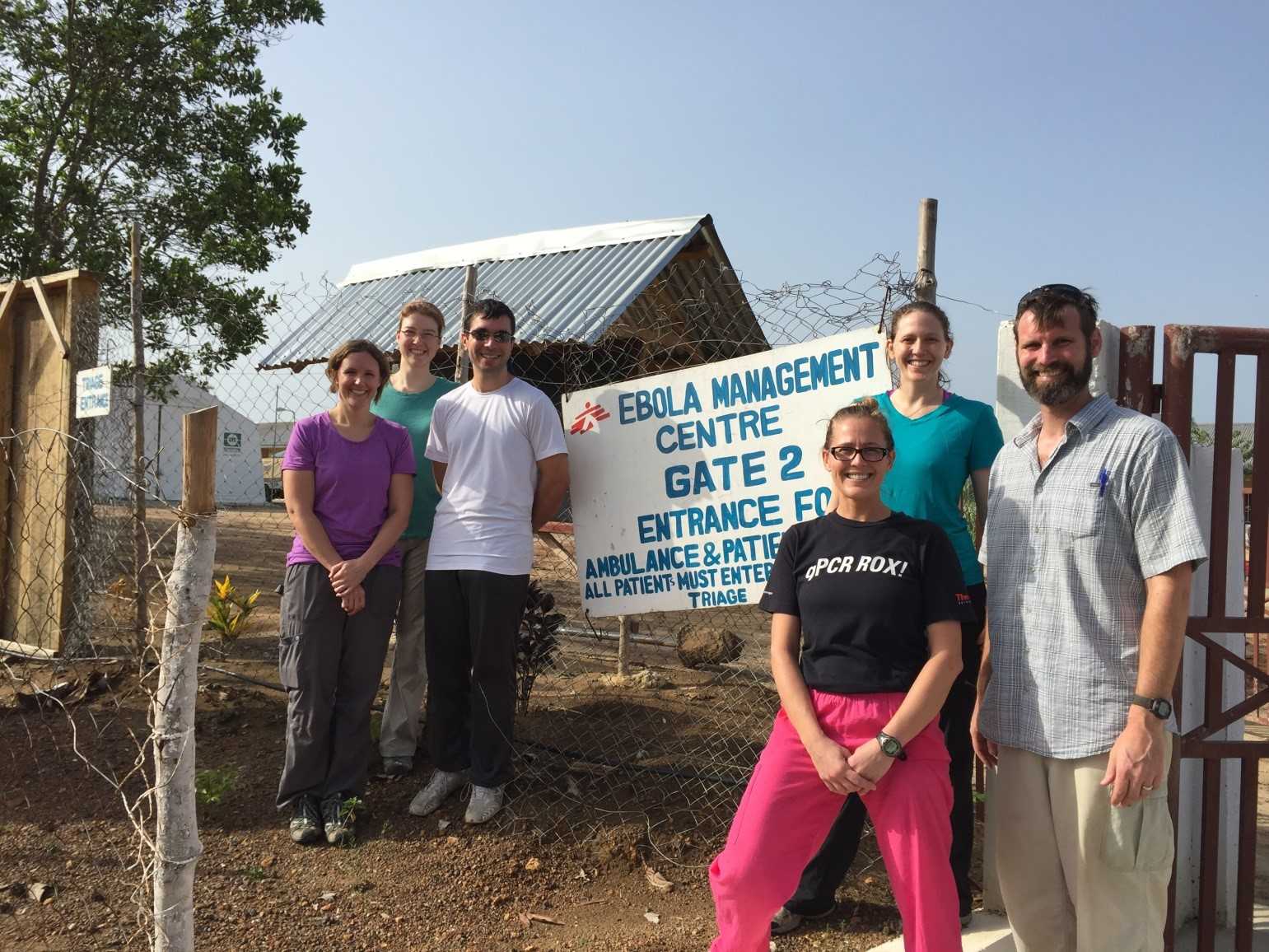Experiences in the Field: Life as a Laboratorian

While in Liberia, John helped transition U.S. Army and U.S. Department of Defense laboratories to U.S. government partner organizations. Pictured above in Tapita, Liberia
In West Africa, the results of each Ebola test can have dramatic, life-altering consequences for patients and communities. A negative test result might mean release from a hospital or Ebola treatment unit (ETU) after a long illness for a survivor or peace of mind for a person suspected to have Ebola. A positive test result could mean admittance to an ETU, movement of a current patient into deeper isolation, and quarantine of loved ones who had direct contact with the patient. In Sierra Leone and Liberia, these tests are often performed by labs affiliated with the United States.
CDC runs a lab in Bo, Sierra Leone, and jointly runs a lab in Liberia with the National Institutes of Health (NIH). The Bo lab is responsible for all samples coming from a geographical area representing almost 50% of the country. It was one of the first labs opened in the early stages of the outbreak. The lab, which started testing samples on August 22, 2014, has processed over 16,000 samples as of May 20, 2015. In contrast, past Ebola outbreaks typically would result in about 1,000 samples being tested.
Receiving so many samples from a large region is only one of many challenges faced by the field labs. Samples can arrive at the lab by many different methods, from motorbike to helicopter. In Liberia, most samples arrive by motorbike. John Saindon, the lab coordinator for Liberia from November 2014 through January 2015, established transportation routes for getting samples to testing sites. At the start of his deployment, it could take up to 5 to 7 days for test results to be reported. This was due in large part to the amount of time it took for samples to reach the testing sites. By working with U.S. Government partners, such as Global Communities, associated with USAID, and improving the alignment of the four Army labs, two Navy labs, and the joint CDC/NIH lab with the country’s ETUs, they reduced the turnaround time for reporting results to less than 24 hours from the time of sample collection.
The samples, which can number up to 175 per day, arrive at the CDC lab in Bo in all different types of containers and are not always labeled well, says Brian Bird, another CDC laboratorian who recently returned from his third deployment to Sierra Leone, where he served as team lead.
“We’ve had syringes with needles on them stuck in these containers, samples in coffee pots, and glass jars. This time I received two 50 milliliter Falcon tubes (plastic, screw cap tubes common in U. S. laboratories) filled with blood. It’s quite impressive, and a challenge,” he said.
Poor labeling of samples poses another challenge when it comes to reporting results. When samples are not clearly labeled (for example, no name, two different names, patient marked as both dead and alive, no location, no date of symptom onset or sample collection), laboratorians would attempt to contact surveillance officers or physicians in the field to determine the sample source. At the end of each day, the laboratorians compile the test results in spreadsheets and report the results to the ministry of health. In Sierra Leone, laboratorians usually use satellite internet to send the results; however, the signal is not always reliable. At those times and in the early days of the outbreak, Brian would rely on his Blackberry to send the results. In Liberia, the results are sent by email using phones. For some labs in Liberia, the laboratorians have to travel up to 30 miles to get a cell signal.

Members of the Bo lab (Team 12) standing in front of the entrance to the Médecins Sans Frontières compound, where the lab is located. (Left to right) Janae Stovall, Laura Rose, Marko Zivcec, Lauren Andersen, Shannon Emery, and Brian Bird
It takes a special kind of laboratorian to volunteer to work in a field laboratory. These laboratorians work 10-14 hours a day in extreme conditions, wearing full personal protective equipment when handling patient samples; temperatures in the lab are routinely in the high nineties. In addition to knowing protocols and equipment used to test the samples, they also must be familiar with how electrical generators work, electrical wiring, and how to maintain supply and cold chains. If the power fails or there is a delay in receiving supplies, they must improvise.
Because of the high demands of the work, rotations are usually limited to 30 days. The Bo lab has had 14 teams of four laboratorians. Volunteers for this lab have come from CDC in Atlanta and Fort Collins, Colorado. For the lab in Liberia, volunteers have come from CDC and NIH Rocky Mountain Laboratories in Montana. Before deploying to West Africa, each team member of the Bo lab receives training by experienced CDC personnel in Atlanta on the equipment they will use and the lab workflow.
Due to the ongoing need for laboratory field teams, CDC is looking for full-time laboratory advisors for Guinea, Liberia, and Sierra Leone to provide support for supply chain management; coordinate sample transportation and tracking; and coordinate between ministries of health, CDC country offices, CDC Emergency Operations Center in Atlanta, and partner organizations staffing field laboratories to improve in-country laboratory system capacities.
Despite the challenges of working in and supporting the field labs in West Africa, both John and Brian have found the experience to be rewarding.
“When we were in Kenema, one of the highlights of my public health career was on one day when we discharged 12 to 14 children all at one time. They were so full of life. It was like looking at the future of Sierra Leone after it had come through such a horrible tragedy, but there it was looking you right in the face. These happy kids, happy to go out of this weird place they had been the past two months. That memory sticks with me a lot,” said Brian.
John was also surprised by how friendly and appreciative the people of Liberia were.
“I felt very proud to be serving there. I had a CDC shirt on or other information that said CDC and people would actually salute me and say thank you and basically tell us that they loved us and everything…I travel a lot and just their appreciation for America is huge. They consider themselves as America’s little brother.”
- Page last reviewed: May 22, 2015
- Page last updated: May 22, 2015
- Content source:




 ShareCompartir
ShareCompartir